Sally's Case Study: Pregnancy, Birth, and Postpartum
VerifiedAdded on 2022/10/15
|9
|2272
|209
Case Study
AI Summary
This case study examines Sally's journey through pregnancy, labor (intrapartum), and the postpartum period, addressing the physiological changes she experiences. The analysis covers key aspects such as hormonal shifts (estrogen, progesterone, oxytocin, prolactin), the use of TENS machines for pain management, the role of maternal positioning during labor, and different approaches to placental delivery (active vs. expectant management). It further explores changes in fetal circulation at birth, the initiation and maintenance of lactation, and the overall adaptations the body undergoes. The study emphasizes the importance of understanding these physiological processes for effective midwifery practice, including the ability to support women through various stages of pregnancy and childbirth, and providing appropriate care and support. The case study also explores the role of hormones like CRH and prostaglandins and discusses how they influence labor and delivery.

Running head: SALLY’S CASE SCENARIO 1
Sally’s Case Scenario
Student’s Name
Institutional Affiliation
Sally’s Case Scenario
Student’s Name
Institutional Affiliation
Secure Best Marks with AI Grader
Need help grading? Try our AI Grader for instant feedback on your assignments.
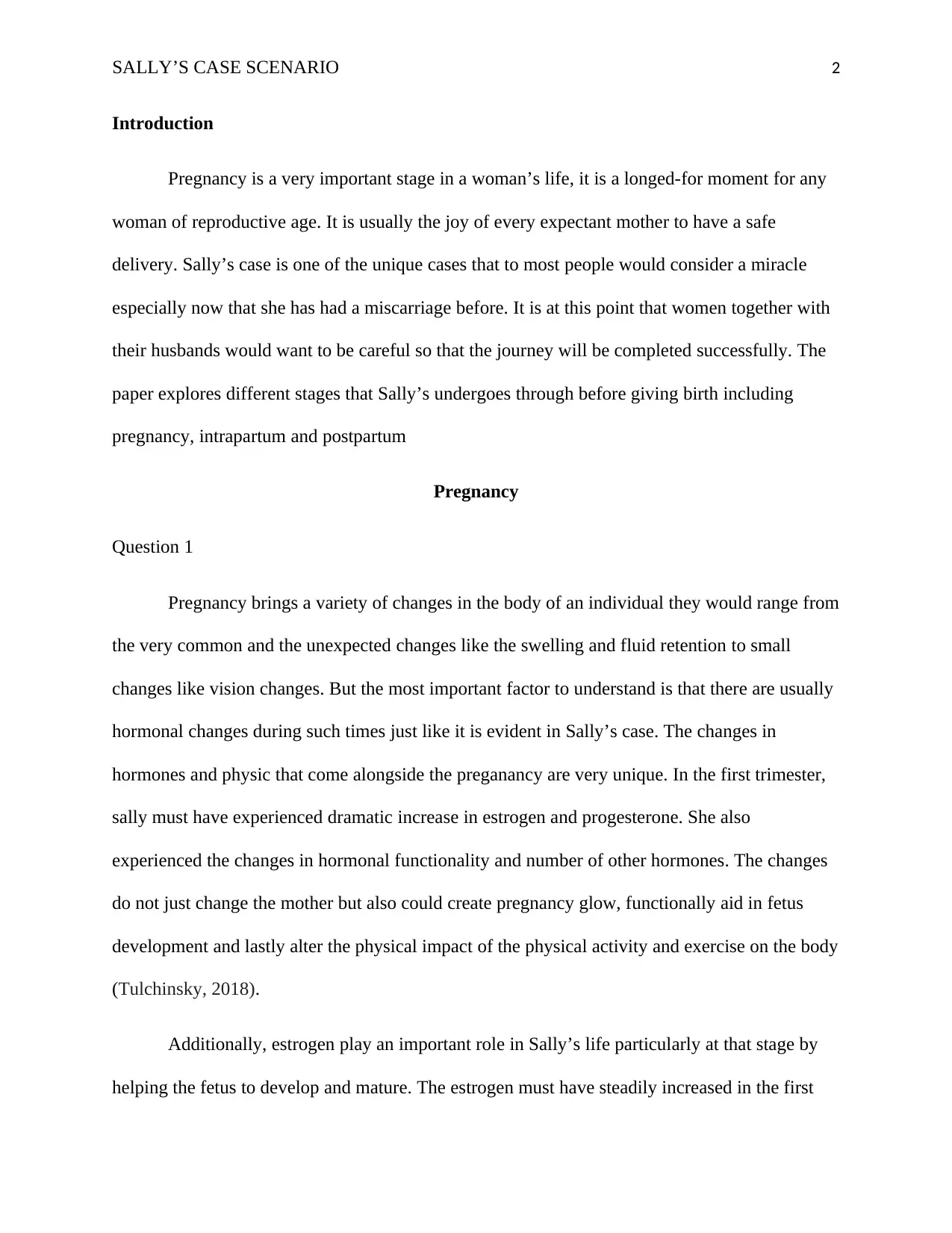
SALLY’S CASE SCENARIO 2
Introduction
Pregnancy is a very important stage in a woman’s life, it is a longed-for moment for any
woman of reproductive age. It is usually the joy of every expectant mother to have a safe
delivery. Sally’s case is one of the unique cases that to most people would consider a miracle
especially now that she has had a miscarriage before. It is at this point that women together with
their husbands would want to be careful so that the journey will be completed successfully. The
paper explores different stages that Sally’s undergoes through before giving birth including
pregnancy, intrapartum and postpartum
Pregnancy
Question 1
Pregnancy brings a variety of changes in the body of an individual they would range from
the very common and the unexpected changes like the swelling and fluid retention to small
changes like vision changes. But the most important factor to understand is that there are usually
hormonal changes during such times just like it is evident in Sally’s case. The changes in
hormones and physic that come alongside the preganancy are very unique. In the first trimester,
sally must have experienced dramatic increase in estrogen and progesterone. She also
experienced the changes in hormonal functionality and number of other hormones. The changes
do not just change the mother but also could create pregnancy glow, functionally aid in fetus
development and lastly alter the physical impact of the physical activity and exercise on the body
(Tulchinsky, 2018).
Additionally, estrogen play an important role in Sally’s life particularly at that stage by
helping the fetus to develop and mature. The estrogen must have steadily increased in the first
Introduction
Pregnancy is a very important stage in a woman’s life, it is a longed-for moment for any
woman of reproductive age. It is usually the joy of every expectant mother to have a safe
delivery. Sally’s case is one of the unique cases that to most people would consider a miracle
especially now that she has had a miscarriage before. It is at this point that women together with
their husbands would want to be careful so that the journey will be completed successfully. The
paper explores different stages that Sally’s undergoes through before giving birth including
pregnancy, intrapartum and postpartum
Pregnancy
Question 1
Pregnancy brings a variety of changes in the body of an individual they would range from
the very common and the unexpected changes like the swelling and fluid retention to small
changes like vision changes. But the most important factor to understand is that there are usually
hormonal changes during such times just like it is evident in Sally’s case. The changes in
hormones and physic that come alongside the preganancy are very unique. In the first trimester,
sally must have experienced dramatic increase in estrogen and progesterone. She also
experienced the changes in hormonal functionality and number of other hormones. The changes
do not just change the mother but also could create pregnancy glow, functionally aid in fetus
development and lastly alter the physical impact of the physical activity and exercise on the body
(Tulchinsky, 2018).
Additionally, estrogen play an important role in Sally’s life particularly at that stage by
helping the fetus to develop and mature. The estrogen must have steadily increased in the first
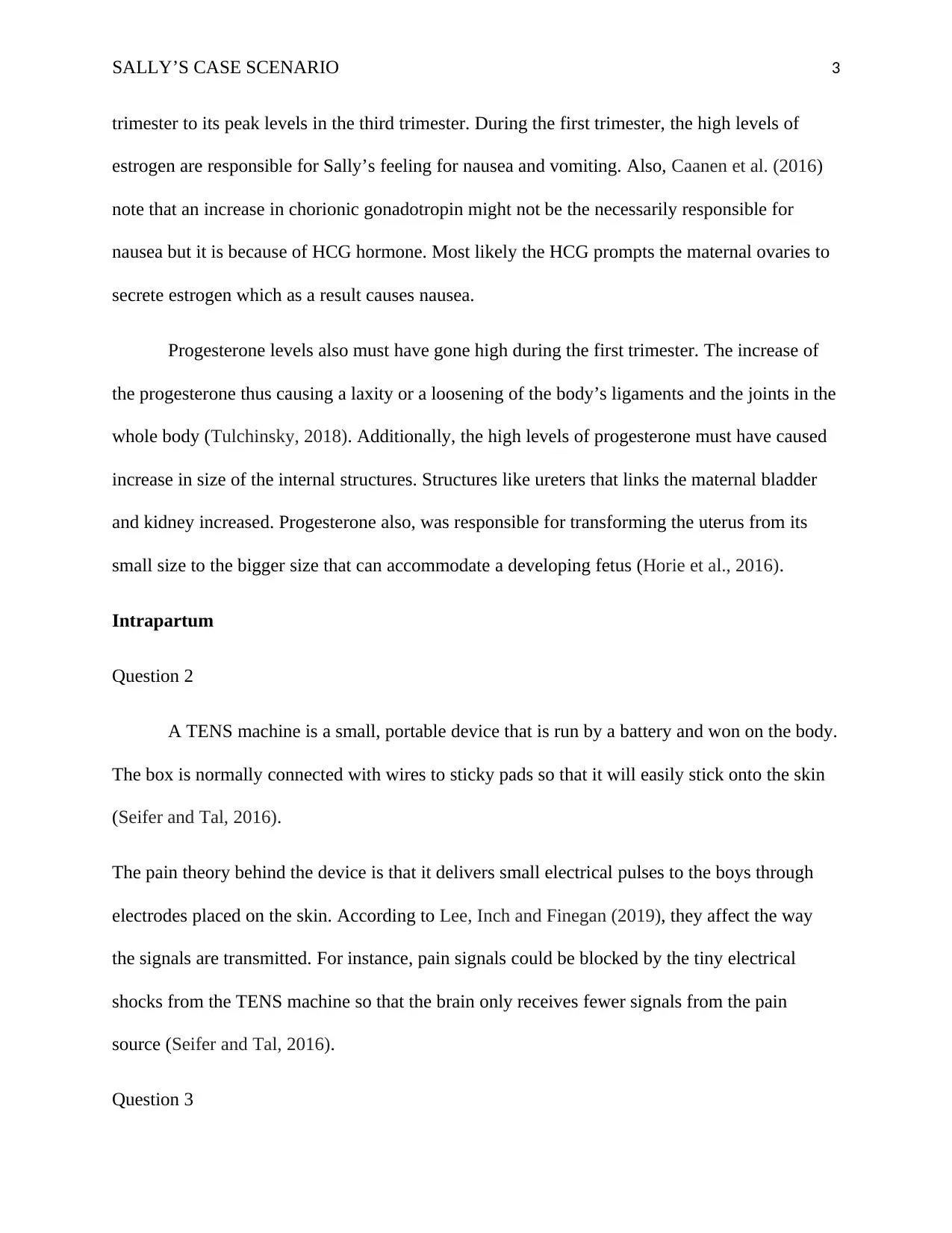
SALLY’S CASE SCENARIO 3
trimester to its peak levels in the third trimester. During the first trimester, the high levels of
estrogen are responsible for Sally’s feeling for nausea and vomiting. Also, Caanen et al. (2016)
note that an increase in chorionic gonadotropin might not be the necessarily responsible for
nausea but it is because of HCG hormone. Most likely the HCG prompts the maternal ovaries to
secrete estrogen which as a result causes nausea.
Progesterone levels also must have gone high during the first trimester. The increase of
the progesterone thus causing a laxity or a loosening of the body’s ligaments and the joints in the
whole body (Tulchinsky, 2018). Additionally, the high levels of progesterone must have caused
increase in size of the internal structures. Structures like ureters that links the maternal bladder
and kidney increased. Progesterone also, was responsible for transforming the uterus from its
small size to the bigger size that can accommodate a developing fetus (Horie et al., 2016).
Intrapartum
Question 2
A TENS machine is a small, portable device that is run by a battery and won on the body.
The box is normally connected with wires to sticky pads so that it will easily stick onto the skin
(Seifer and Tal, 2016).
The pain theory behind the device is that it delivers small electrical pulses to the boys through
electrodes placed on the skin. According to Lee, Inch and Finegan (2019), they affect the way
the signals are transmitted. For instance, pain signals could be blocked by the tiny electrical
shocks from the TENS machine so that the brain only receives fewer signals from the pain
source (Seifer and Tal, 2016).
Question 3
trimester to its peak levels in the third trimester. During the first trimester, the high levels of
estrogen are responsible for Sally’s feeling for nausea and vomiting. Also, Caanen et al. (2016)
note that an increase in chorionic gonadotropin might not be the necessarily responsible for
nausea but it is because of HCG hormone. Most likely the HCG prompts the maternal ovaries to
secrete estrogen which as a result causes nausea.
Progesterone levels also must have gone high during the first trimester. The increase of
the progesterone thus causing a laxity or a loosening of the body’s ligaments and the joints in the
whole body (Tulchinsky, 2018). Additionally, the high levels of progesterone must have caused
increase in size of the internal structures. Structures like ureters that links the maternal bladder
and kidney increased. Progesterone also, was responsible for transforming the uterus from its
small size to the bigger size that can accommodate a developing fetus (Horie et al., 2016).
Intrapartum
Question 2
A TENS machine is a small, portable device that is run by a battery and won on the body.
The box is normally connected with wires to sticky pads so that it will easily stick onto the skin
(Seifer and Tal, 2016).
The pain theory behind the device is that it delivers small electrical pulses to the boys through
electrodes placed on the skin. According to Lee, Inch and Finegan (2019), they affect the way
the signals are transmitted. For instance, pain signals could be blocked by the tiny electrical
shocks from the TENS machine so that the brain only receives fewer signals from the pain
source (Seifer and Tal, 2016).
Question 3
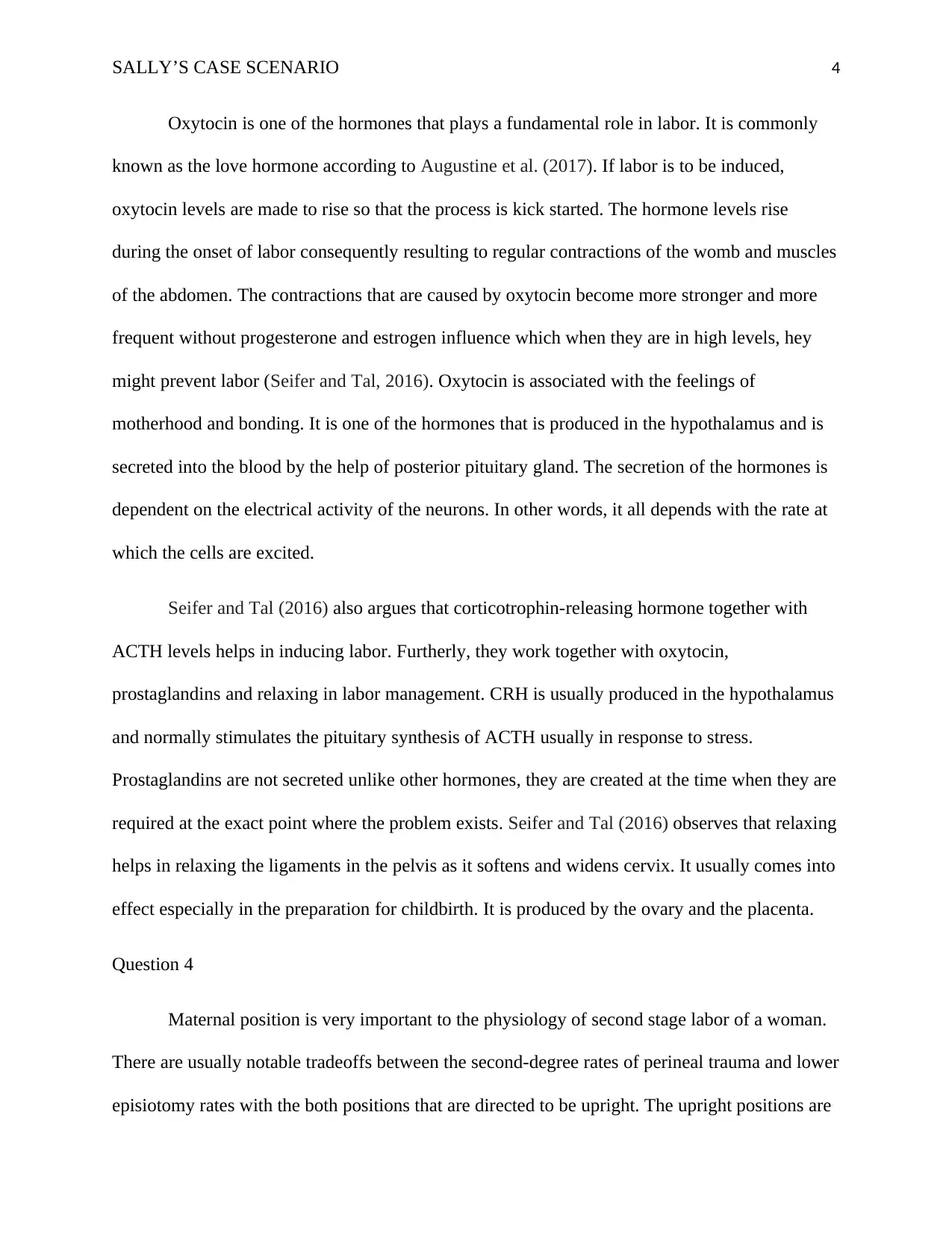
SALLY’S CASE SCENARIO 4
Oxytocin is one of the hormones that plays a fundamental role in labor. It is commonly
known as the love hormone according to Augustine et al. (2017). If labor is to be induced,
oxytocin levels are made to rise so that the process is kick started. The hormone levels rise
during the onset of labor consequently resulting to regular contractions of the womb and muscles
of the abdomen. The contractions that are caused by oxytocin become more stronger and more
frequent without progesterone and estrogen influence which when they are in high levels, hey
might prevent labor (Seifer and Tal, 2016). Oxytocin is associated with the feelings of
motherhood and bonding. It is one of the hormones that is produced in the hypothalamus and is
secreted into the blood by the help of posterior pituitary gland. The secretion of the hormones is
dependent on the electrical activity of the neurons. In other words, it all depends with the rate at
which the cells are excited.
Seifer and Tal (2016) also argues that corticotrophin-releasing hormone together with
ACTH levels helps in inducing labor. Furtherly, they work together with oxytocin,
prostaglandins and relaxing in labor management. CRH is usually produced in the hypothalamus
and normally stimulates the pituitary synthesis of ACTH usually in response to stress.
Prostaglandins are not secreted unlike other hormones, they are created at the time when they are
required at the exact point where the problem exists. Seifer and Tal (2016) observes that relaxing
helps in relaxing the ligaments in the pelvis as it softens and widens cervix. It usually comes into
effect especially in the preparation for childbirth. It is produced by the ovary and the placenta.
Question 4
Maternal position is very important to the physiology of second stage labor of a woman.
There are usually notable tradeoffs between the second-degree rates of perineal trauma and lower
episiotomy rates with the both positions that are directed to be upright. The upright positions are
Oxytocin is one of the hormones that plays a fundamental role in labor. It is commonly
known as the love hormone according to Augustine et al. (2017). If labor is to be induced,
oxytocin levels are made to rise so that the process is kick started. The hormone levels rise
during the onset of labor consequently resulting to regular contractions of the womb and muscles
of the abdomen. The contractions that are caused by oxytocin become more stronger and more
frequent without progesterone and estrogen influence which when they are in high levels, hey
might prevent labor (Seifer and Tal, 2016). Oxytocin is associated with the feelings of
motherhood and bonding. It is one of the hormones that is produced in the hypothalamus and is
secreted into the blood by the help of posterior pituitary gland. The secretion of the hormones is
dependent on the electrical activity of the neurons. In other words, it all depends with the rate at
which the cells are excited.
Seifer and Tal (2016) also argues that corticotrophin-releasing hormone together with
ACTH levels helps in inducing labor. Furtherly, they work together with oxytocin,
prostaglandins and relaxing in labor management. CRH is usually produced in the hypothalamus
and normally stimulates the pituitary synthesis of ACTH usually in response to stress.
Prostaglandins are not secreted unlike other hormones, they are created at the time when they are
required at the exact point where the problem exists. Seifer and Tal (2016) observes that relaxing
helps in relaxing the ligaments in the pelvis as it softens and widens cervix. It usually comes into
effect especially in the preparation for childbirth. It is produced by the ovary and the placenta.
Question 4
Maternal position is very important to the physiology of second stage labor of a woman.
There are usually notable tradeoffs between the second-degree rates of perineal trauma and lower
episiotomy rates with the both positions that are directed to be upright. The upright positions are
Secure Best Marks with AI Grader
Need help grading? Try our AI Grader for instant feedback on your assignments.
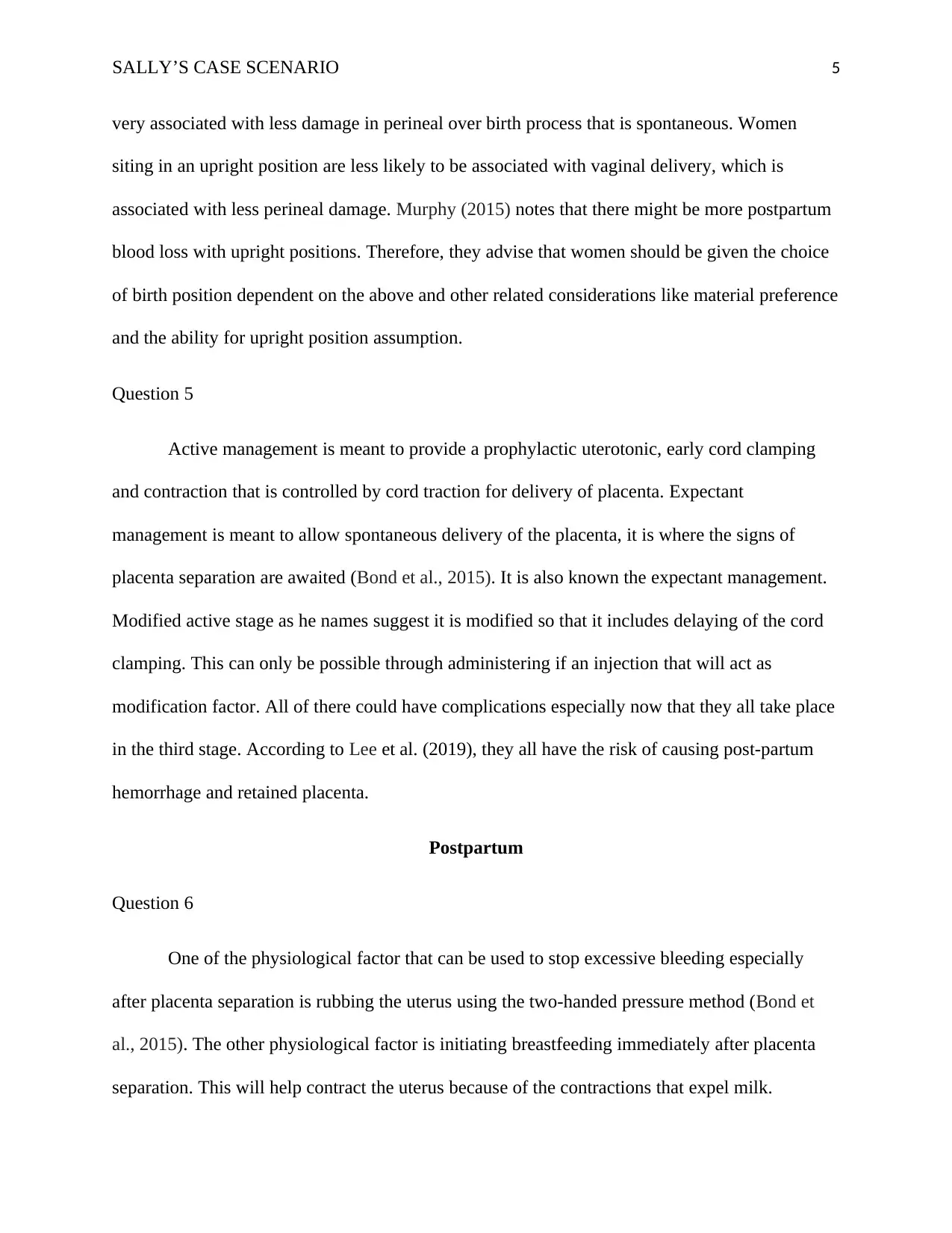
SALLY’S CASE SCENARIO 5
very associated with less damage in perineal over birth process that is spontaneous. Women
siting in an upright position are less likely to be associated with vaginal delivery, which is
associated with less perineal damage. Murphy (2015) notes that there might be more postpartum
blood loss with upright positions. Therefore, they advise that women should be given the choice
of birth position dependent on the above and other related considerations like material preference
and the ability for upright position assumption.
Question 5
Active management is meant to provide a prophylactic uterotonic, early cord clamping
and contraction that is controlled by cord traction for delivery of placenta. Expectant
management is meant to allow spontaneous delivery of the placenta, it is where the signs of
placenta separation are awaited (Bond et al., 2015). It is also known the expectant management.
Modified active stage as he names suggest it is modified so that it includes delaying of the cord
clamping. This can only be possible through administering if an injection that will act as
modification factor. All of there could have complications especially now that they all take place
in the third stage. According to Lee et al. (2019), they all have the risk of causing post-partum
hemorrhage and retained placenta.
Postpartum
Question 6
One of the physiological factor that can be used to stop excessive bleeding especially
after placenta separation is rubbing the uterus using the two-handed pressure method (Bond et
al., 2015). The other physiological factor is initiating breastfeeding immediately after placenta
separation. This will help contract the uterus because of the contractions that expel milk.
very associated with less damage in perineal over birth process that is spontaneous. Women
siting in an upright position are less likely to be associated with vaginal delivery, which is
associated with less perineal damage. Murphy (2015) notes that there might be more postpartum
blood loss with upright positions. Therefore, they advise that women should be given the choice
of birth position dependent on the above and other related considerations like material preference
and the ability for upright position assumption.
Question 5
Active management is meant to provide a prophylactic uterotonic, early cord clamping
and contraction that is controlled by cord traction for delivery of placenta. Expectant
management is meant to allow spontaneous delivery of the placenta, it is where the signs of
placenta separation are awaited (Bond et al., 2015). It is also known the expectant management.
Modified active stage as he names suggest it is modified so that it includes delaying of the cord
clamping. This can only be possible through administering if an injection that will act as
modification factor. All of there could have complications especially now that they all take place
in the third stage. According to Lee et al. (2019), they all have the risk of causing post-partum
hemorrhage and retained placenta.
Postpartum
Question 6
One of the physiological factor that can be used to stop excessive bleeding especially
after placenta separation is rubbing the uterus using the two-handed pressure method (Bond et
al., 2015). The other physiological factor is initiating breastfeeding immediately after placenta
separation. This will help contract the uterus because of the contractions that expel milk.
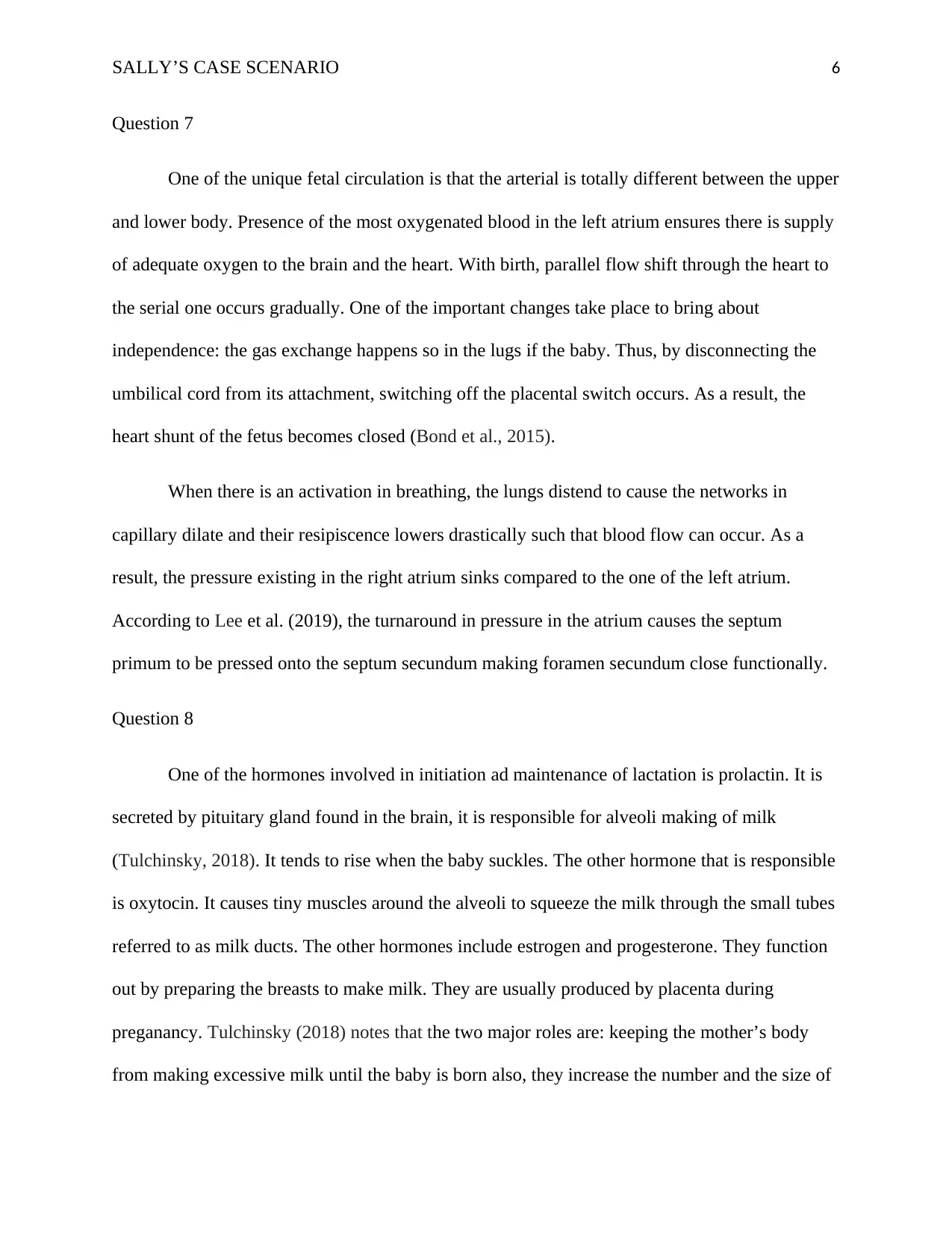
SALLY’S CASE SCENARIO 6
Question 7
One of the unique fetal circulation is that the arterial is totally different between the upper
and lower body. Presence of the most oxygenated blood in the left atrium ensures there is supply
of adequate oxygen to the brain and the heart. With birth, parallel flow shift through the heart to
the serial one occurs gradually. One of the important changes take place to bring about
independence: the gas exchange happens so in the lugs if the baby. Thus, by disconnecting the
umbilical cord from its attachment, switching off the placental switch occurs. As a result, the
heart shunt of the fetus becomes closed (Bond et al., 2015).
When there is an activation in breathing, the lungs distend to cause the networks in
capillary dilate and their resipiscence lowers drastically such that blood flow can occur. As a
result, the pressure existing in the right atrium sinks compared to the one of the left atrium.
According to Lee et al. (2019), the turnaround in pressure in the atrium causes the septum
primum to be pressed onto the septum secundum making foramen secundum close functionally.
Question 8
One of the hormones involved in initiation ad maintenance of lactation is prolactin. It is
secreted by pituitary gland found in the brain, it is responsible for alveoli making of milk
(Tulchinsky, 2018). It tends to rise when the baby suckles. The other hormone that is responsible
is oxytocin. It causes tiny muscles around the alveoli to squeeze the milk through the small tubes
referred to as milk ducts. The other hormones include estrogen and progesterone. They function
out by preparing the breasts to make milk. They are usually produced by placenta during
preganancy. Tulchinsky (2018) notes that the two major roles are: keeping the mother’s body
from making excessive milk until the baby is born also, they increase the number and the size of
Question 7
One of the unique fetal circulation is that the arterial is totally different between the upper
and lower body. Presence of the most oxygenated blood in the left atrium ensures there is supply
of adequate oxygen to the brain and the heart. With birth, parallel flow shift through the heart to
the serial one occurs gradually. One of the important changes take place to bring about
independence: the gas exchange happens so in the lugs if the baby. Thus, by disconnecting the
umbilical cord from its attachment, switching off the placental switch occurs. As a result, the
heart shunt of the fetus becomes closed (Bond et al., 2015).
When there is an activation in breathing, the lungs distend to cause the networks in
capillary dilate and their resipiscence lowers drastically such that blood flow can occur. As a
result, the pressure existing in the right atrium sinks compared to the one of the left atrium.
According to Lee et al. (2019), the turnaround in pressure in the atrium causes the septum
primum to be pressed onto the septum secundum making foramen secundum close functionally.
Question 8
One of the hormones involved in initiation ad maintenance of lactation is prolactin. It is
secreted by pituitary gland found in the brain, it is responsible for alveoli making of milk
(Tulchinsky, 2018). It tends to rise when the baby suckles. The other hormone that is responsible
is oxytocin. It causes tiny muscles around the alveoli to squeeze the milk through the small tubes
referred to as milk ducts. The other hormones include estrogen and progesterone. They function
out by preparing the breasts to make milk. They are usually produced by placenta during
preganancy. Tulchinsky (2018) notes that the two major roles are: keeping the mother’s body
from making excessive milk until the baby is born also, they increase the number and the size of
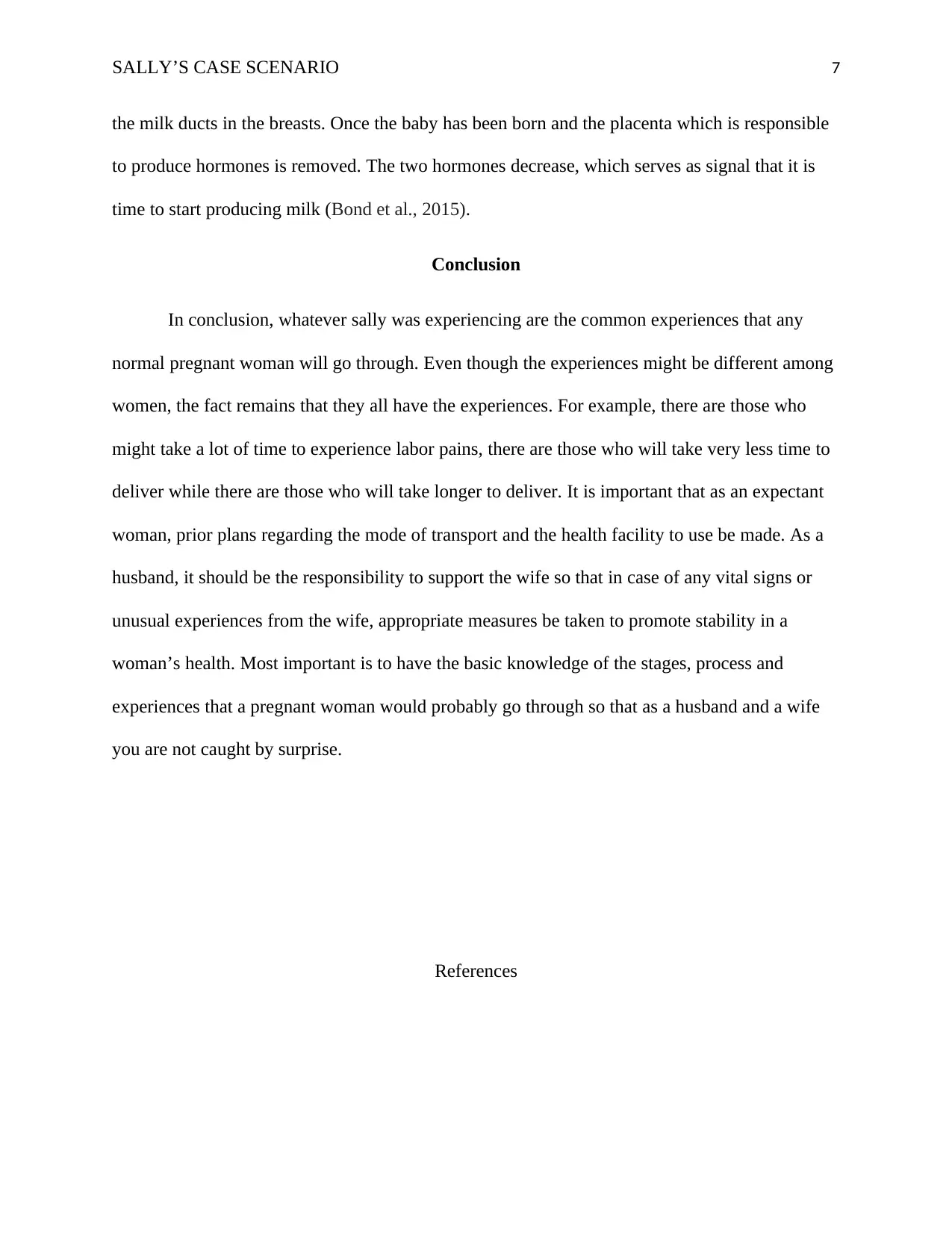
SALLY’S CASE SCENARIO 7
the milk ducts in the breasts. Once the baby has been born and the placenta which is responsible
to produce hormones is removed. The two hormones decrease, which serves as signal that it is
time to start producing milk (Bond et al., 2015).
Conclusion
In conclusion, whatever sally was experiencing are the common experiences that any
normal pregnant woman will go through. Even though the experiences might be different among
women, the fact remains that they all have the experiences. For example, there are those who
might take a lot of time to experience labor pains, there are those who will take very less time to
deliver while there are those who will take longer to deliver. It is important that as an expectant
woman, prior plans regarding the mode of transport and the health facility to use be made. As a
husband, it should be the responsibility to support the wife so that in case of any vital signs or
unusual experiences from the wife, appropriate measures be taken to promote stability in a
woman’s health. Most important is to have the basic knowledge of the stages, process and
experiences that a pregnant woman would probably go through so that as a husband and a wife
you are not caught by surprise.
References
the milk ducts in the breasts. Once the baby has been born and the placenta which is responsible
to produce hormones is removed. The two hormones decrease, which serves as signal that it is
time to start producing milk (Bond et al., 2015).
Conclusion
In conclusion, whatever sally was experiencing are the common experiences that any
normal pregnant woman will go through. Even though the experiences might be different among
women, the fact remains that they all have the experiences. For example, there are those who
might take a lot of time to experience labor pains, there are those who will take very less time to
deliver while there are those who will take longer to deliver. It is important that as an expectant
woman, prior plans regarding the mode of transport and the health facility to use be made. As a
husband, it should be the responsibility to support the wife so that in case of any vital signs or
unusual experiences from the wife, appropriate measures be taken to promote stability in a
woman’s health. Most important is to have the basic knowledge of the stages, process and
experiences that a pregnant woman would probably go through so that as a husband and a wife
you are not caught by surprise.
References
Paraphrase This Document
Need a fresh take? Get an instant paraphrase of this document with our AI Paraphraser
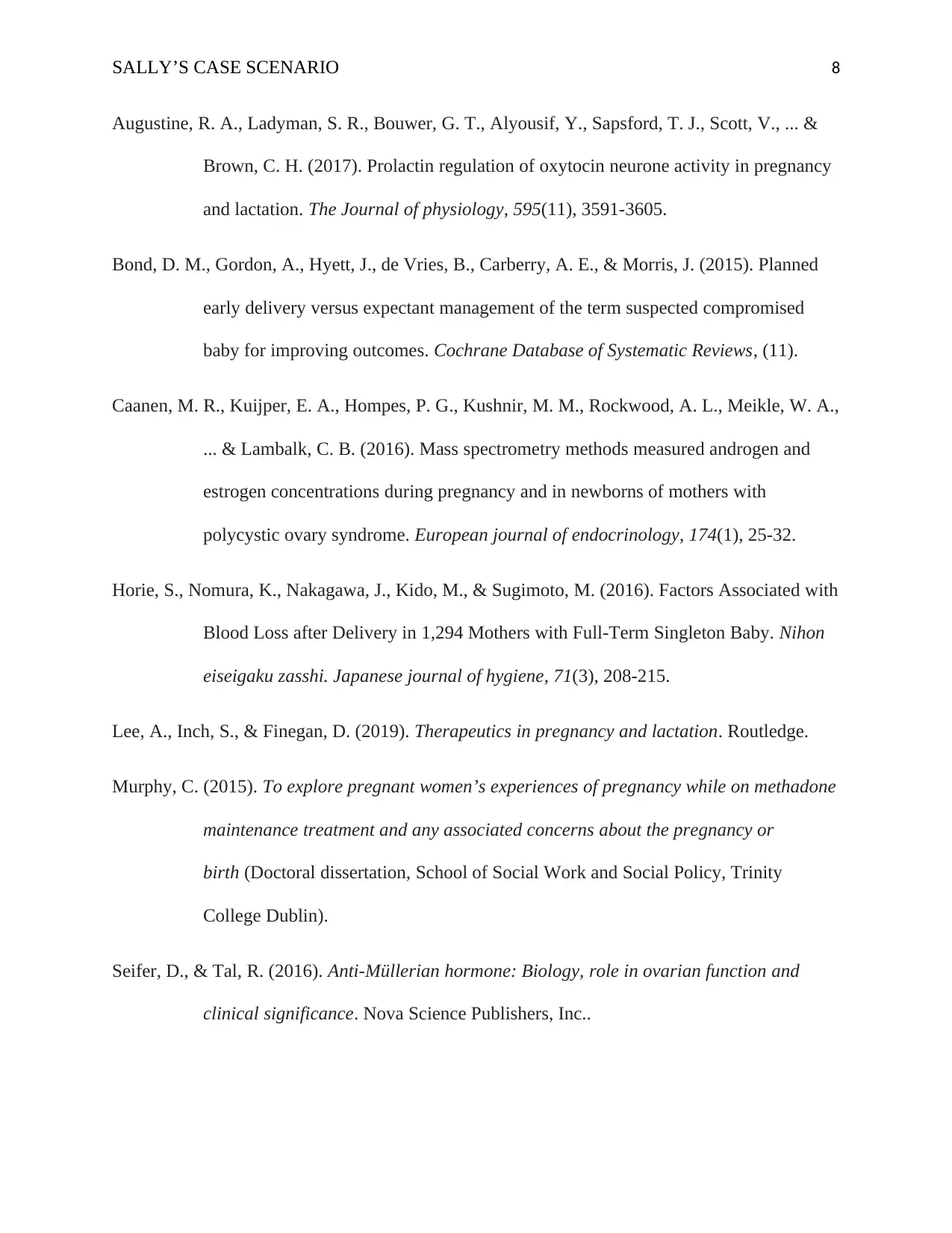
SALLY’S CASE SCENARIO 8
Augustine, R. A., Ladyman, S. R., Bouwer, G. T., Alyousif, Y., Sapsford, T. J., Scott, V., ... &
Brown, C. H. (2017). Prolactin regulation of oxytocin neurone activity in pregnancy
and lactation. The Journal of physiology, 595(11), 3591-3605.
Bond, D. M., Gordon, A., Hyett, J., de Vries, B., Carberry, A. E., & Morris, J. (2015). Planned
early delivery versus expectant management of the term suspected compromised
baby for improving outcomes. Cochrane Database of Systematic Reviews, (11).
Caanen, M. R., Kuijper, E. A., Hompes, P. G., Kushnir, M. M., Rockwood, A. L., Meikle, W. A.,
... & Lambalk, C. B. (2016). Mass spectrometry methods measured androgen and
estrogen concentrations during pregnancy and in newborns of mothers with
polycystic ovary syndrome. European journal of endocrinology, 174(1), 25-32.
Horie, S., Nomura, K., Nakagawa, J., Kido, M., & Sugimoto, M. (2016). Factors Associated with
Blood Loss after Delivery in 1,294 Mothers with Full-Term Singleton Baby. Nihon
eiseigaku zasshi. Japanese journal of hygiene, 71(3), 208-215.
Lee, A., Inch, S., & Finegan, D. (2019). Therapeutics in pregnancy and lactation. Routledge.
Murphy, C. (2015). To explore pregnant women’s experiences of pregnancy while on methadone
maintenance treatment and any associated concerns about the pregnancy or
birth (Doctoral dissertation, School of Social Work and Social Policy, Trinity
College Dublin).
Seifer, D., & Tal, R. (2016). Anti-Müllerian hormone: Biology, role in ovarian function and
clinical significance. Nova Science Publishers, Inc..
Augustine, R. A., Ladyman, S. R., Bouwer, G. T., Alyousif, Y., Sapsford, T. J., Scott, V., ... &
Brown, C. H. (2017). Prolactin regulation of oxytocin neurone activity in pregnancy
and lactation. The Journal of physiology, 595(11), 3591-3605.
Bond, D. M., Gordon, A., Hyett, J., de Vries, B., Carberry, A. E., & Morris, J. (2015). Planned
early delivery versus expectant management of the term suspected compromised
baby for improving outcomes. Cochrane Database of Systematic Reviews, (11).
Caanen, M. R., Kuijper, E. A., Hompes, P. G., Kushnir, M. M., Rockwood, A. L., Meikle, W. A.,
... & Lambalk, C. B. (2016). Mass spectrometry methods measured androgen and
estrogen concentrations during pregnancy and in newborns of mothers with
polycystic ovary syndrome. European journal of endocrinology, 174(1), 25-32.
Horie, S., Nomura, K., Nakagawa, J., Kido, M., & Sugimoto, M. (2016). Factors Associated with
Blood Loss after Delivery in 1,294 Mothers with Full-Term Singleton Baby. Nihon
eiseigaku zasshi. Japanese journal of hygiene, 71(3), 208-215.
Lee, A., Inch, S., & Finegan, D. (2019). Therapeutics in pregnancy and lactation. Routledge.
Murphy, C. (2015). To explore pregnant women’s experiences of pregnancy while on methadone
maintenance treatment and any associated concerns about the pregnancy or
birth (Doctoral dissertation, School of Social Work and Social Policy, Trinity
College Dublin).
Seifer, D., & Tal, R. (2016). Anti-Müllerian hormone: Biology, role in ovarian function and
clinical significance. Nova Science Publishers, Inc..

SALLY’S CASE SCENARIO 9
Tulchinsky, D. (2018). Hormonal Changes in Pregnancy as Indicators of Fetoplacental Function.
In Biochemistry of Women (pp. 85-101). CRC Press.
Tulchinsky, D. (2018). Hormonal Changes in Pregnancy as Indicators of Fetoplacental Function.
In Biochemistry of Women (pp. 85-101). CRC Press.
1 out of 9
Related Documents
Your All-in-One AI-Powered Toolkit for Academic Success.
+13062052269
info@desklib.com
Available 24*7 on WhatsApp / Email
![[object Object]](/_next/static/media/star-bottom.7253800d.svg)
Unlock your academic potential
© 2024 | Zucol Services PVT LTD | All rights reserved.





